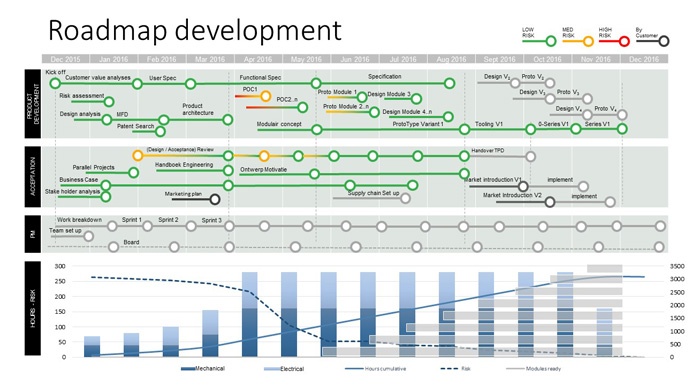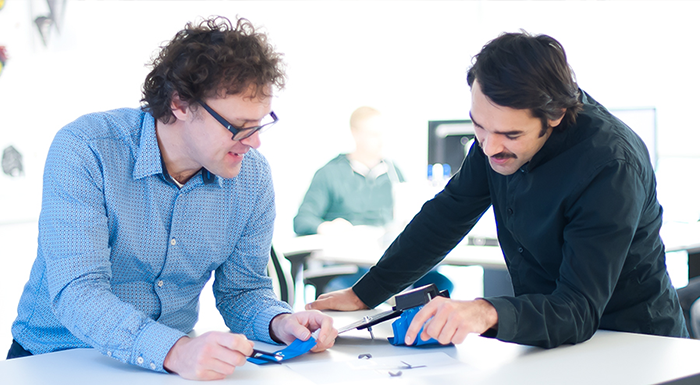
You have a vision of your future product portfolio, but it is not very detailed yet. Your vision contains uncertainties, but does provide sufficient indication of where you want to be in 1 to 3 years. What is more, the project team can’t wait to begin. But how do you make sure that the workload is divided the right way and the activities are carried out efficiently?
A good tool for translating your vision into concrete plans is an engineering roadmap. In this blog article I will show you the strength of the roadmap. I will also provide you with 6 tips that can help you set up a good roadmap yourself.
Before you start developing your roadmap, it is good to realise what a roadmap actually is and what its advantages are.
The strength of a roadmap
A roadmap creates a clear, communicable vision. The strength of this is:
- It stimulates people to think along. Because a roadmap provides insight in both the end goal and the steps towards it, more people will understand how activities connect and contribute to the bigger picture. This provides the project team with inspiration and it will stimulate the members to think along;
- It acts as a safeguard when making decisions. Hundreds of decisions, big and small, will have to be made, when realising a product portfolio that matches your vision. Because the roadmap shows the bigger picture, it can be used for the daily choices that have to be made. It secures: “doing the right things, instead of doing things right”
- A roadmap acts as a safeguard for the various departments in order to realistically assess and plan capacity and expenses. The roadmap acts as a framework for, for example, project plans, capacity planning, budgets and progress presentations made within the company.
Difference between a roadmap and a planning
A roadmap is something different than a planning. The goal of a roadmap is to communicate a vision by only showing the essence of a development or challenge. It focuses on risk reduction and acceptance, while a planning focuses on turnaround times, capacity and quality.
6 tips for setting up a roadmap
Now the concept and the importance of a roadmap are clear, here are 6 tips for setting up a good roadmap.
Tip 1: start with determining your ultimate goal
Start with determining your ultimate goal. The best way to do this is by asking questions such as ‘what is problem that needs to be solved?’, ‘why is it a problem?’ and ‘what is the revenue model?’ Work your way back from there. Do not try to fill in all details yet, because at this point there are still matters you do not know about. Name and prioritise them in the roadmap. Make sure that the biggest risks or uncertainties are dealt with without any delay. Low risk matters can be dealt with later.
Tip 2: visualise
Make it visual and make sure that it fits on A3 size paper and is readable. The major goal is communicating your vision. The best way to do this is with an organised, visual summary, which you can easily fall back on during talks. To make things even more clear, you can enrich the texts and the goals in the roadmap with concept drawings which depict the future situation.
Tip 3: create support
Involve the stakeholders in setting up the roadmap. By formulating the roadmap together, you will create a basis for support and also integrate the essential interests. The sooner you involve people and have them think along, the quicker your plan will be accepted and propagated.
Tip 4: continue to update
Keep the roadmap alive by updating it regularly. Especially when it concerns the longer terms of 1-3 years, a market can be far too dynamic. Therefore new insights will pop up regularly. Verify the fundamental starting points of the roadmap on a regular basis. When you notice that other demands are made with regard to your product or company, then do not wait too long with a change of course.
Tip 5: define short sprints
Define short sprints with 6 to 8 weeks turnaround time. Big, long-term projects without roadmaps are inclined to fail when it comes to planning and feasibility. They overrun with regard to budget, and teams get confused and stunned by the complexity of it all.
By dividing the capacity and budget of a big project into several smaller and manageable projects chances of success increase significantly. By means of short term goals, it is clear for everyone what is expected of him or her and towards what they should work. Because of this the team will stay energetic. What would really be great is if you could disclose the results of the sprints midway. However, this is only possible when your product portfolio is set up in a highly modular way. You can then put on the market the modules that have already been developed, while other modules are still in the process of development.
Tip 6: identify need for knowledge and means
Besides the intended ultimate goal, it is a good thing to indicate in your roadmap all your essential information, means and acceptance points. You will want to identify as early as possible the need for specific, critical knowledge or means, so that you can organise this. The same goes for acceptance. By thinking really carefully in this stage about the acceptance of various activities of your roadmap, you will define the right activities with which you can reduce delays and risks.
Do you want more information or do you want help with your roadmap? Please get in contact.












